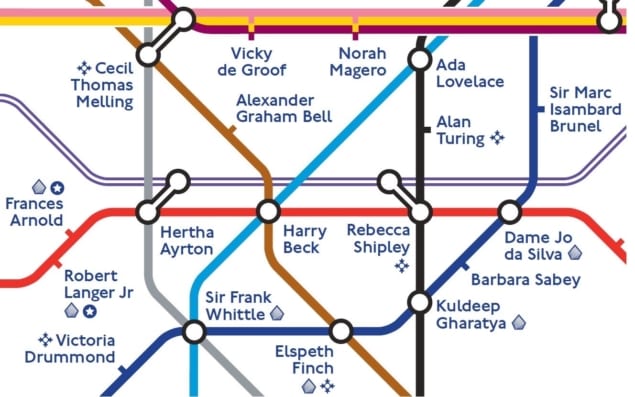
Perhaps the most iconic map ever is Harry Beck’s depiction of the London Underground, which first appeared in the 1930s. Now, Transport for London (TfL) – which runs the Underground – has partnered with the Royal Academy of Engineering to create a Tube-themed map that depicts famous people in the history of engineering. Created to celebrate National Engineering Day on 1 November, the entire map can be viewed here.
The American artist Jackson Pollock was famous for abstract paintings made by dripping paint onto canvasses. It turns out that there is a lot of physics in Pollock’s technique. As viscous liquids are poured, there is a rich range of behaviour that can occur. A thin stream of paint can twist around in circles like a coiling rope, and a broad sheet of paint can fall in a cascade of folds.
Apparently, Pollock was a master of manipulating these effects to create his stunning paintings. Now, the applied mathematician L Mahadevan has come up with a way to use some of the same effects with a 3D printer. Based at Harvard University in the US, Mahadevan and colleagues were able to use their system to create a range of complicated 3D shapes.
Fluid instabilities
The work is based on two decades of fluid-dynamics research by Mahadevan, which explains how instabilities in fluid flow result in effects like coiling and folding. “We wanted to develop a technique that could take advantage of the folding and coiling instabilities, rather than avoid them,” says Gaurav Chaudhary, who worked on the project.
The team designed an algorithm that worked out how to manipulate the printer nozzle using a technique called deep reinforcement learning. As well as creating Pollock-style paintings, the team also used their technique to decorate a cookie with chocolate syrup.
The technique is described in Soft Matter.
Canada made the transition from imperial measurements to the metric system in the mid-1970s. So fellow Canadians my age were taught both systems at school – and are very good at converting between systems. However, our neighbours to the south have so far resisted the metric system, much to the amusement of the rest of the world – and the consternation of some Americans.
[embedded content]
The above comedy sketch from Saturday Night Live explores America’s relationship with imperial measures at the founding of the nation. George Washington expounds on the virtues of having 5280 feet in a mile. He also touches on the puzzling fact that (in the future) soda pop in the US will often be sold by the litre, whereas paint and milk will be sold by the gallon.
I think the writers missed a trick by mentioning the ultimate irony of Washington’s enthusiasm for the imperial system – the fact that it was invented by his arch enemy, the British.
- SEO Powered Content & PR Distribution. Get Amplified Today.
- PlatoData.Network Vertical Generative Ai. Empower Yourself. Access Here.
- PlatoAiStream. Web3 Intelligence. Knowledge Amplified. Access Here.
- PlatoESG. Carbon, CleanTech, Energy, Environment, Solar, Waste Management. Access Here.
- PlatoHealth. Biotech and Clinical Trials Intelligence. Access Here.
- Source: https://physicsworld.com/a/tube-map-of-famous-engineers-physics-of-jackson-pollock-george-washingtons-imperial-love/
- :has
- :is
- $UP
- 1
- 3d
- a
- Able
- above
- ABSTRACT
- Academy
- ADvantage
- age
- algorithm
- also
- American
- Americans
- amusement
- an
- and
- appeared
- applied
- ARE
- around
- artist
- AS
- At
- avoid
- based
- BE
- behaviour
- between
- both
- British
- broad
- by
- called
- CAN
- Canadians
- cascade
- celebrate
- Chocolate
- circles
- colleagues
- come
- Comedy
- complicated
- content
- converting
- could
- create
- created
- Creating
- day
- decades
- deep
- described
- designed
- develop
- dream
- effects
- embedded
- Engineering
- Engineers
- enthusiasm
- Entire
- EVER
- Explains
- explores
- fact
- Fall
- famous
- far
- Feet
- fellow
- First
- flow
- fluid
- folds
- For
- founding
- from
- future
- George
- good
- harvard
- harvard university
- Have
- having
- he
- his
- history
- How
- How To
- However
- HTTPS
- iconic
- icons
- image
- Imperial
- in
- information
- Invented
- irony
- issue
- IT
- Jackson
- jpg
- learning
- like
- live
- London
- Lot
- love
- made
- manipulating
- map
- master
- max-width
- measurements
- measures
- metric
- Milk
- missed
- most
- much
- my
- nation
- National
- New
- night
- November
- now
- of
- often
- on
- onto
- our
- out
- paintings
- partnered
- People
- Physics
- Physics World
- plato
- Plato Data Intelligence
- PlatoData
- pop
- project
- range
- rather
- relationship
- research
- REST
- result
- Rich
- royal
- runs
- s
- same
- saturday
- says
- School
- Section
- shapes
- sheet
- small
- So
- so Far
- sold
- some
- South
- stream
- Stunning
- system
- Systems
- Take
- taught
- team
- technique
- TFL
- than
- that
- The
- The Future
- the world
- their
- Them
- There.
- These
- think
- thumbnail
- to
- touches
- transition
- transport
- true
- turns
- twist
- two
- ultimate
- underground
- university
- us
- use
- used
- using
- very
- wanted
- was
- washington
- Way..
- WELL
- were
- whereas
- which
- WHO
- will
- with
- Work
- worked
- world
- writers
- youtube
- zephyrnet













